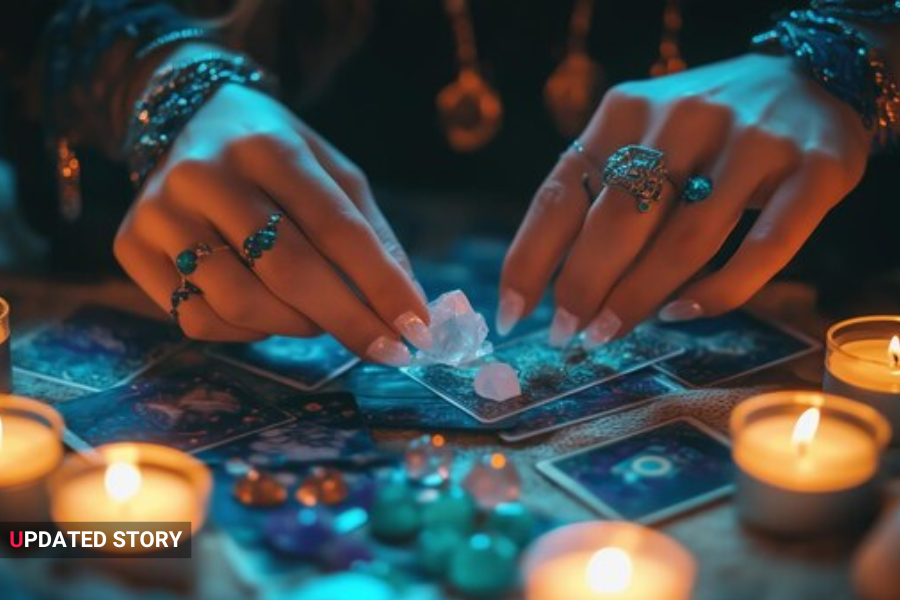Tarot Readings for Understanding Personal Dynamics: A Practical Guide
Tarot readings have been around for centuries, evolving into a popular tool for gaining insights into various aspects of life, from love to career decisions. While often viewed as a mystical or spiritual practice, tarot can also serve as a valuable tool for understanding personal dynamics—how we interact with others, our inner emotional landscape, and how these factors influence our relationships and day-to-day experiences.
Whether you are new to tarot or an experienced reader, using the cards to explore personal dynamics offers a unique way to reflect on your behaviors, reactions, and emotional responses. This blog post will dive deep into how tarot can help you understand your personal dynamics, the science behind it, and practical ways to incorporate it into your life.
What Are Personal Dynamics?
Before diving into how tarot readings can help understand personal dynamics, let’s define what personal dynamics actually are. Personal dynamics refer to the interactions and relationships between individuals—be it family, friends, colleagues, or romantic partners—and the emotional, psychological, and social forces that drive these interactions.
These dynamics can be shaped by:
- Personality traits
- Emotional intelligence
- Communication styles
- Past experiences and traumas
- Values and beliefs
In relationships, personal dynamics play a crucial role in how people relate to one another, resolve conflicts, and express love, trust, and affection. By understanding the nuances of personal dynamics, you can become more self-aware, improve your interactions with others, and ultimately foster more meaningful and balanced relationships.
Tarot as a Tool for Personal Insight
While tarot cards are often associated with fortune-telling, their primary value lies in their ability to serve as mirrors of the subconscious. A well-structured tarot reading can help you uncover hidden emotions, repressed thoughts, and unexplored aspects of your personality, offering a pathway to better understanding your role in various personal dynamics.
There are normally 78 cards in a tarot deck, which are separated into the Major Arcana and the Minor Arcana. The Major Arcana cards represent significant life events, transitions, or spiritual lessons, while the Minor Arcana is more about day-to-day occurrences, emotions, and situations. Together, these cards offer a comprehensive snapshot of your emotional, mental, and spiritual state.
How Tarot Can Illuminate Personal Dynamics
1. Exploring Hidden Emotions
Tarot is often used to reveal what is happening beneath the surface—hidden emotions or unconscious behaviors that influence how we interact with others. For example, if you’re facing challenges in your relationship, a tarot reading might bring attention to issues of trust, fear of vulnerability, or unresolved past trauma that you haven’t fully addressed.
Cards such as The Moon or The High Priestess can highlight areas of confusion, emotional blockages, or intuition that you may not have considered. When you understand your emotional patterns, you can take proactive steps to improve how you relate to others.
2. Understanding Your Communication Style
Communication plays a critical role in all relationships. Sometimes, misunderstandings or miscommunications occur because individuals have different ways of expressing themselves or interpreting the words and actions of others. Tarot can help uncover these dynamics.
For instance, the Page of Swords may point to a tendency to communicate impulsively, while the Queen of Cups might suggest a more empathetic and emotionally driven communication style. By identifying these tendencies, you can work on improving your communication with others and develop better strategies for expressing your thoughts and feelings.
3. Identifying Toxic Patterns
Certain recurring patterns of behavior can influence personal dynamics in harmful ways. These patterns may arise from past trauma, limiting beliefs, or unhealthy relationship dynamics. The Devil card in tarot is often associated with unhealthy attachments or addictions, whether emotional, physical, or mental.
If you draw this card during a reading, it could be a sign that you’re stuck in a negative pattern that is affecting your relationships. Recognizing these patterns through tarot readings allows you to address and work through these challenges, ultimately freeing yourself from behaviors that no longer serve your well-being.
4. Exploring Relationship Dynamics
Tarot can be especially helpful for gaining clarity on specific relationship dynamics, whether romantic, familial, or professional. It helps uncover not only how you contribute to the relationship but also how your partner, family member, or colleague interacts with you.
The Two of Cups, for example, represents a balanced partnership, indicating a harmonious dynamic in romantic relationships. In contrast, the Five of Wands may represent conflict and competition in a relationship, signaling the need for more cooperation.
A tarot reading that focuses on the dynamics between you and someone else can provide insights into both the strengths and challenges of your connection. It can also reveal areas where improvement or change is needed for the relationship to grow in a healthy direction.
5. Self-Reflection and Personal Growth
Perhaps one of the most significant ways tarot can influence personal dynamics is through fostering self-reflection and encouraging personal growth. The Hermit card, for example, represents introspection and the need for solitude to gain deeper insight. It can indicate that taking time for yourself, away from the noise of others, is crucial for gaining clarity on your feelings and actions.
Personal growth through tarot readings often involves accepting the parts of yourself that you may not like, understanding how your behaviors affect those around you, and working to develop healthier relationships with both yourself and others.
Using Tarot for Practical Guidance
Now that we’ve explored how tarot readings can illuminate personal dynamics, let’s talk about how you can use tarot readings practically to improve your relationships and emotional well-being. Here are some methods to consider:
1. One-Card Daily Draw
A one-card daily draw is an easy and accessible way to begin incorporating tarot into your self-reflection practice. Draw a single card each day and reflect on its message in relation to your current emotional state or relationships. Ask questions like:
- What do I need to understand about my current relationship dynamics?
- What hidden emotions should I be aware of today?
- How can I improve my communication with others today?
This simple practice can help you tune into your inner wisdom and make conscious choices that positively impact your personal dynamics.
2. Three-Card Spread
A more in-depth spread can help you dive deeper into specific areas of your life. A common three-card spread for understanding personal dynamics might involve drawing three cards with the following questions:
- Where am I emotionally?
- What is influencing my relationships?
- What can I do to improve my personal dynamics?
The insights gained from this spread can serve as a helpful guide for understanding and improving your interactions with others.
3. Relationship Spread
If you’re looking to explore the dynamics of a specific relationship, consider using a tarot spread dedicated to relationships. A relationship spread can focus on the roles both individuals play, what each person needs emotionally, and what obstacles may exist between them. Some common questions for this type of reading might include:
- How does my partner view our relationship?
- What do I bring to the table in this relationship?
- What is the potential for growth or healing in this relationship?
By gaining clarity on your relationship’s dynamics, you can make more informed decisions about how to move forward.
4. Shadow Work with Tarot
Shadow work refers to the practice of exploring the parts of yourself that you might suppress or ignore—those aspects that can influence your behavior in unhealthy ways. Tarot can be a powerful tool for shadow work, as it brings to the surface repressed feelings, fears, and unresolved issues. Cards like The Tower (representing sudden upheaval) or The Devil (symbolizing toxic behavior patterns) can act as gateways to deeper introspection.
Regularly engaging in shadow work through tarot can help you become more aware of how your unresolved issues may affect your personal dynamics, allowing you to make conscious changes for healthier interactions with others.
Is Tarot a Science?
While tarot is not a science in the traditional sense, many people find that tarot readings provide valuable insights that lead to personal growth and clarity. Tarot does not rely on empirical evidence in the same way that fields like psychology or biology do, but it offers a powerful tool for exploring the subconscious mind, emotional triggers, and relationship patterns.
It’s important to approach tarot with an open mind, using it as a reflective tool rather than relying on it for concrete answers. The real value comes from how tarot prompts you to explore your emotions, relationships, and personal dynamics in a meaningful way.
Conclusion
Tarot readings for understanding personal dynamics offer a powerful avenue for self-discovery, emotional insight, and healthier relationships. By using tarot as a reflective tool, you can uncover hidden patterns, improve communication, and gain a deeper awareness of how you interact with others. Whether you’re navigating a romantic relationship, handling workplace dynamics, or simply exploring your emotional responses, tarot provides a unique lens to view your inner world.
With regular practice—through daily draws, specific spreads, or shadow work—tarot can become a transformative part of your personal growth journey. Remember, the true magic of tarot lies not in predicting the future, but in illuminating the present so that you can move forward with intention, empathy, and clarity.
FAQs
1. What are tarot readings for understanding personal dynamics?
Tarot readings for understanding personal dynamics focus on exploring how you relate to others and yourself emotionally, mentally, and energetically. These readings aim to uncover communication patterns, emotional triggers, and behavioral tendencies that influence your interactions and relationships.
2. Do I need to be a professional tarot reader to explore personal dynamics?
Not at all! Whether you’re a beginner or experienced reader, you can use simple spreads and daily draws to gain insights into your personal dynamics. The key is to approach tarot with curiosity, honesty, and a willingness to reflect.
3. How often should I do tarot readings for personal dynamics?
There’s no fixed rule, but many people find value in doing a one-card draw daily or a deeper reading weekly. For specific relationship concerns or emotional patterns, you might choose to do readings as needed.
4. Which tarot cards are most relevant to personal dynamics?
Cards like The High Priestess, The Moon, The Devil, The Hermit, and The Lovers often surface in readings focused on personal dynamics. These cards highlight introspection, emotions, communication, attachments, and relationship themes.
5. Can tarot really help improve my relationships?
While tarot doesn’t “fix” relationships, it can provide clarity about your role within them. By offering insight into emotions, communication styles, and behavioral patterns, tarot readings can guide you toward healthier, more conscious interactions.
6. Is there any science behind tarot readings for understanding personal dynamics?
Tarot isn’t a science in the traditional sense, but it draws on principles of psychology and self-reflection. Many people find that tarot helps them tap into their subconscious, explore their emotions, and make more mindful decisions—similar to journaling or talk therapy.
7. How do I start using tarot for personal insight?
Start simple with a daily card draw. Ask reflective questions like “What do I need to know about my emotions today?” or “How can I improve my interactions with others?” You can also explore three-card or relationship-specific spreads for deeper insights.






